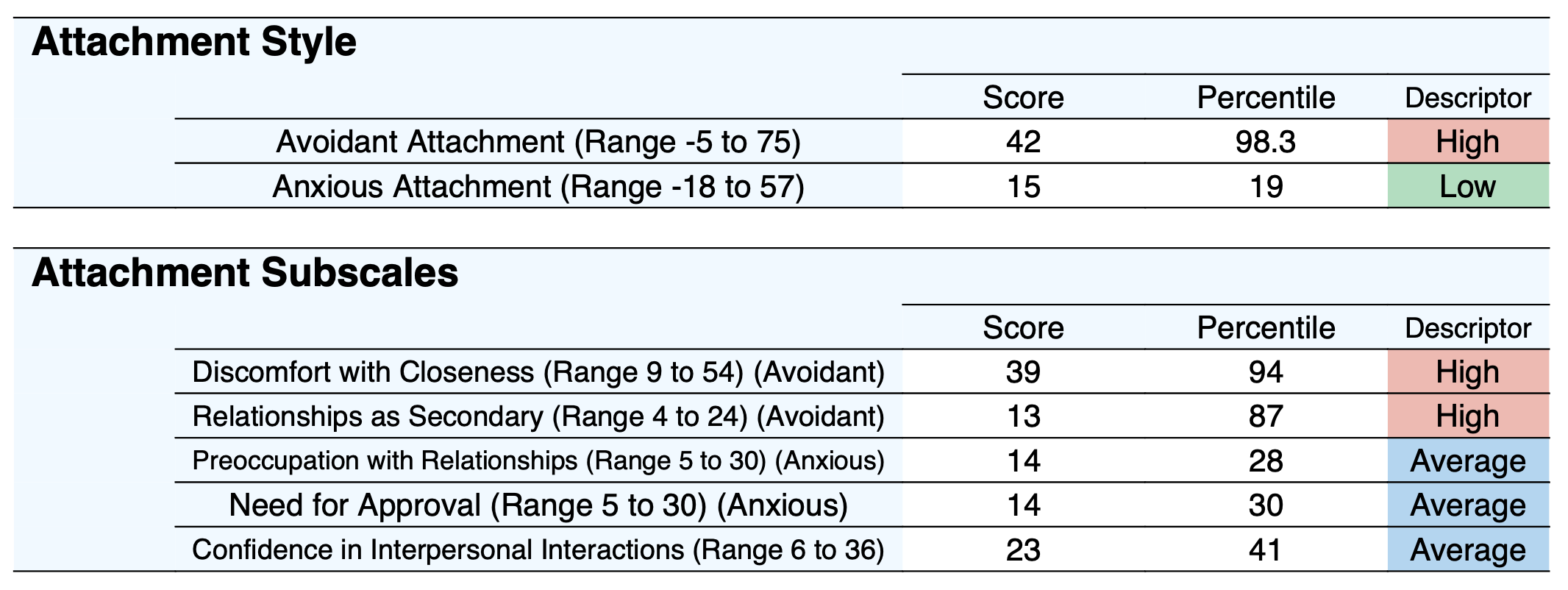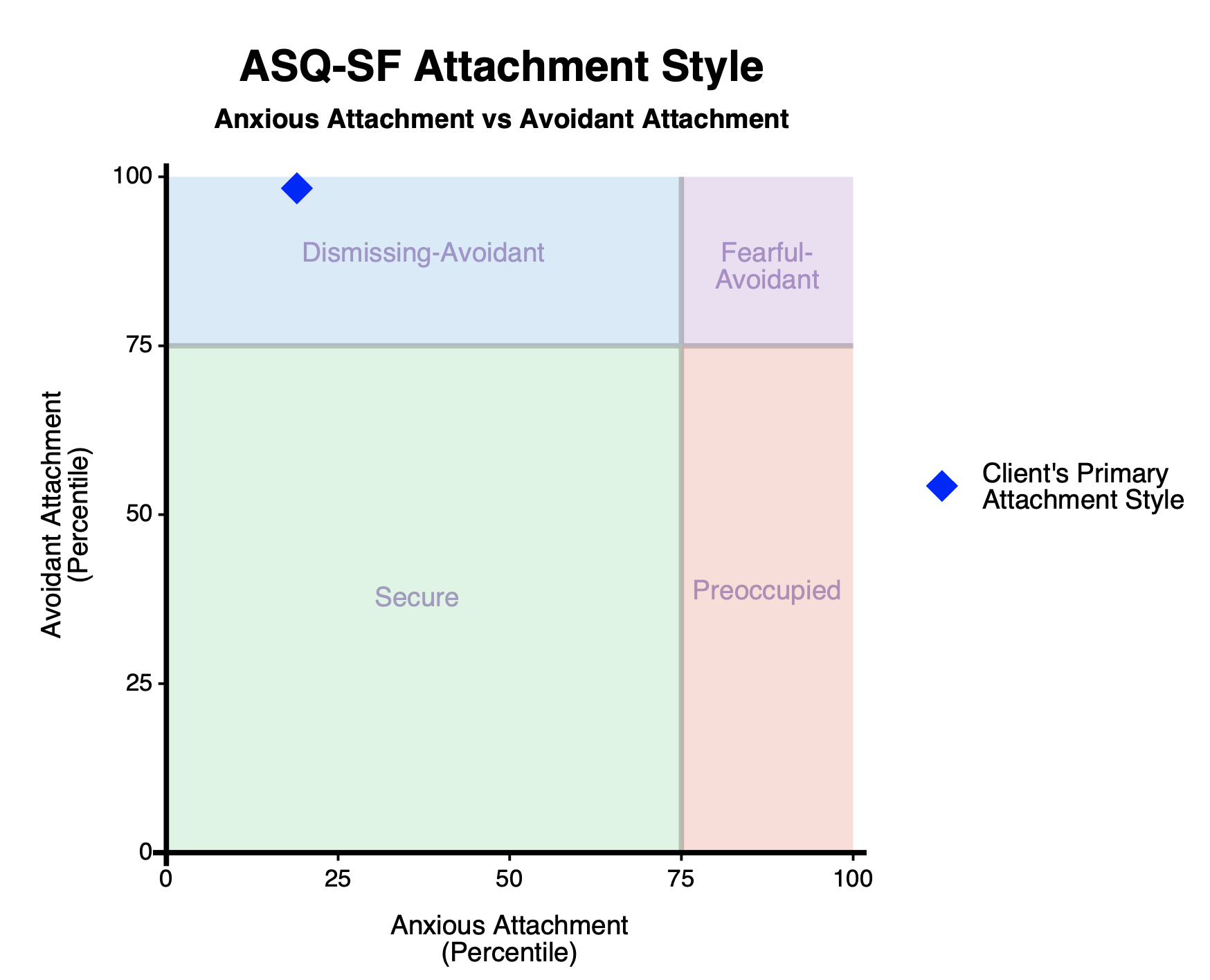The Attachment Style Questionnaire – Short Form (ASQ-SF) is a 29-item self-report measure widely used to assess adult attachment patterns in both non-clinical and mental health contexts (Alexander et al., 2001; Karantzas et al., 2010).
Based on attachment theory’s fundamental premise that humans possess an innate socio-biological need to form and maintain strong affectional bonds, the ASQ-SF evaluates how individuals approach and manage relationships across their lifespan (Bowlby, 1988; Mikulincer & Shaver, 2016). This attachment drive serves multiple adaptive functions, including enhancing survival through proximity-seeking behaviours during periods of distress or threat, facilitating emotion regulation, and providing a secure base for exploration and personal growth (Karantzas et al., 2010; Fraley & Shaver, 2000).
The scale is structured around two primary dimensions of adult attachment, representing the major patterns of attachment-related anxiety and avoidance:
These main dimensions are further refined through five specific subscales that provide detailed insight into interpersonal relationship patterns:
A distinctive strength of the ASQ-SF lies in its deliberately broad conceptualisation of attachment relationships, utilising language that extends beyond romantic partnerships (Karantzas et al., 2010). This broader focus enables assessment across diverse populations, including adolescents and individuals with limited romantic relationship experience. The measure’s versatility makes it particularly valuable for understanding developmental trajectories in attachment patterns and their influence on various interpersonal contexts, including therapeutic relationships, family dynamics, and peer interactions (Karantzas et al., 2010; Mikulincer & Shaver, 2016).
The ASQ-SF is a contemporary attachment measure; its dimensional and subscale structure provides a nuanced understanding of attachment patterns, thus addressing limitations of existing attachment measures which conceptualise attachment as a categorical construct. In their comprehensive systematic review, Pollard et al. (2023) identified the ASQ-SF as one of the most robust and psychometrically sound measures available for attachment assessment.
The assessment of attachment patterns through the ASQ-SF provides insights that inform case conceptualisation, treatment planning, and therapeutic process (Levy et al., 2018). Understanding a client’s attachment style helps predict potential challenges in the therapeutic alliance, anticipate transference patterns, and guide interventions that promote secure attachment development (Daniel, 2006). Research indicates that attachment patterns are significantly associated with various psychopathological presentations, including depression, anxiety, personality disorders, and interpersonal difficulties (Dozier et al., 2008). Additionally, attachment assessment can help identify specific mechanisms maintaining psychological distress, such as maladaptive emotion regulation strategies, interpersonal schemas, and patterns of seeking or avoiding support (Malik et al., 2015). The detailed subscale structure of the ASQ-SF allows clinicians to target interventions more precisely, addressing specific aspects of attachment insecurity while building on existing strengths in interpersonal functioning (Wallin, 2007). Furthermore, attachment patterns have been shown to influence treatment outcomes across various therapeutic modalities, making attachment assessment valuable for treatment selection and modification (Mikulincer et al., 2013).
Scores consist of two main attachment styles, Avoidant Attachment and Anxious Attachment alongside subscales. The scoring system is based on a combination of direct subscale scores and adjustments using the Confidence subscale items to provide a more nuanced measure of attachment security:

The five subscales provide detailed information about specific aspects of attachment and interpersonal functioning:

Each score is converted to a percentile based on normative data, and descriptors (Low, Average, High) are assigned based on percentile ranges (Hegarty et al., 2024):
Percentiles are computed based on an adult community sample, where a percentile of 50 represents typical patterns of responding. Participants in the community sample (n = 3,576) ranged in age from 15 to 73 years and were predominantly (90%) of Anglo-Australian background.
The interpretative text includes the Primary Attachment Pattern Analysis (Hegarty et al., 2024). This pattern analysis is based upon the specific combination of score descriptors (Low, Average, High) across all dimensions. These patterns range from secure styles (e.g., “Secure Style”) to various insecure patterns (e.g., “Fearful-Avoidant Style”, “Dismissive-Avoidant Style”). Each pattern provides specific insights into attachment organisation and relationship dynamics, along with associated therapeutic implications and approaches. The interpretation considers interactions between the avoidant and anxious scales to provide a comprehensive understanding of the person’s attachment style and its implications for relationships and therapeutic work. The specificity of the overall Attachment Pattern allows for highly tailored therapeutic recommendations and insights into potential treatment challenges and opportunities.
The 29-item ASQ-SF by Alexander et al. (2001) was derived from the 40-item Attachment Style Questionnaire by Feeney et al. (1994). Karantzas et al. (2010) demonstrated that of the two scales (ASQ and ASQ-SF), the ASQ-SF is the superior, more parsimonious attachment measure. While both versions showed similar, satisfying values of subscale internal consistency (α = 0.72 – 0.85), the best factor model fit was found in the short form (Karantzas et al., 2010). Results suggest that the multidimensional structure of the ASQ-SF allows for important distinctions in people’s attachment cognitions and behaviours (Karantzas et al., 2010). In doing so, these measures capture key elements of attachment styles that are important in understanding the nature of human attachment.
Normative data from adults collected by Karantzas and colleagues (2010) has been synthesised to produce means and standard deviations for scores and subscales (see Table 6, Karantzas et al., 2010). This data is used to compute percentiles (Hegarty et al., 2024). The sample consisted of 3,576 participants selected from the wider community in eastern Australian states and territories. Participants ranged in age from 15 to 73 years (M = 25.67 years, SD = 11.20) and were predominantly (90%) of Anglo-Australian background.
NovoPsych determined descriptors for each of the attachment scores and subscale scores that are determined by percentiles (Hegarty et al., 2024). The percentile ranges chosen were consistent with previous attachment researchers (e.g., Mayseless & Scher, 2000; Kaitz et al., 2004; Rain et al., 2016):
The NovoPsych version of the ASQ-SF employs a sophisticated pattern analysis system that examines the interplay between avoidant and anxious attachment dimensions. These attachment patterns were developed by three PhD level psychologists with extensive clinical experience (Hegarty et al., 2024). The analysis generates attachment pattern interpretations based on specific combinations of scores across dimensions. Patterns focus on the fundamental interaction between anxious and avoidant attachment dimensions, categorising individuals into broader attachment styles. For example:
This dual-level pattern analysis system, supported by empirical attachment research (Bartholomew & Horowitz, 1991; Brennan et al., 1998), provides both the specificity needed for clinical intervention and the broader categorical framework useful for research and general understanding of attachment organisation.
Alexander, R., Feeney, J., Hohaus, L., & Noller, P. (2001). Attachment style and coping resources as predictors of coping strategies in the transition to parenthood. Personal Relationships, 8(2), 137–152. https://doi.org/10.1111/j.1475-6811.2001.tb00032.x
Bartholomew, K., & Horowitz, L. M. (1991). Attachment styles among young adults: A test of a four-category model. Journal of Personality and Social Psychology, 61(2), 226–244. https://doi.org/10.1037/0022-3514.61.2.226
Brennan, K. A., Clark, C. L., & Shaver, P. R. (1998). Self-report measurement of adult attachment: An integrative overview. In J. A. Simpson & W. S. Rholes (Eds.), Attachment theory and close relationships (pp. 46-76). Guilford Press.
Bowlby, J. (1988). A secure base: Parent-child attachment and healthy human development. Basic Books.
Daniel, S. I. F. (2006). Adult attachment patterns and individual psychotherapy: a review. Clinical Psychology Review, 26(8), 968–984. https://doi.org/10.1016/j.cpr.2006.02.001
Dozier, M., Stovall-McClough, K. C., & Albus, K. E. (2008). Attachment and psychopathology in adulthood. In J. Cassidy & P. R. Shaver (Eds.), Handbook of attachment: Theory, research, and clinical applications (2nd ed., pp. 718-744). Guilford Press.
Feeney, J. A., Noller, P., & Hanrahan, M. (1994). Assessing adult attachment. In M. B. Sperling & W. H. Berman (Eds.), Attachment in adults: Clinical and developmental perspectives (pp. 128–152). New York: Guilford Press.
Fraley, R. C., & Shaver, P. R. (2000). Adult romantic attachment: Theoretical developments, emerging controversies, and unanswered questions. Review of General Psychology: Journal of Division 1, of the American Psychological Association, 4(2), 132–154. https://doi.org/10.1037/1089-2680.4.2.132
Hegarty, D., Smyth, C., Buchanan, B., Baker, S., & Bartholomew, E. (2024). A Review of the Clinical Utility and Psychometric Characteristics of the Attachment Style Questionnaire – Short Form (ASQ-SF): Norms, Percentile Rankings, and Qualitative Descriptors.
Kaitz, M., Bar-Haim, Y., Lehrer, M., & Grossman, E. (2004). Adult attachment style and interpersonal distance. Attachment & Human Development, 6(3), 285–304. https://doi.org/10.1080/14616730412331281520
Karantzas, G., Feeney, J. A., & Wilkinson, R. (2010). Is less more? Confirmatory factor analysis of the attachment style questionnaires. https://doi.org/10.1177/0265407510373756
Levy, K. N., Johnson, B. N., Clouthier, T. L., Scala, J. W., & Temes, C. M. (2015). An attachment theoretical framework for personality disorders. Psychologie Canadienne [Canadian Psychology], 56(2), 197–207. https://doi.org/10.1037/cap0000025
Malik, S., Wells, A., & Wittkowski, A. (2015). Emotion regulation as a mediator in the relationship between attachment and depressive symptomatology: A systematic review. Journal of Affective Disorders, 172, 428–444. https://doi.org/10.1016/j.jad.2014.10.007
Mayseless, O., & Scher, A. (2000). Mother’s attachment concerns regarding spouse and infant’s temperament as modulators of maternal separation anxiety. Journal of Child Psychology and Psychiatry, 41(7), 917–925. https://doi.org/10.1111/1469-7610.00679
Mikulincer, M., Shaver, P. R., & Berant, E. (2013). An attachment perspective on therapeutic processes and outcomes: Attachment and therapeutic processes. Journal of Personality, 81(6), 606–616. https://doi.org/10.1111/j.1467-6494.2012.00806.x
Pollard, C., Bucci, S., & Berry, K. (2023). A systematic review of measures of adult disorganized attachment. The British Journal of Clinical Psychology, 62(2), 329–355. https://doi.org/10.1111/bjc.12411
Rain, M., Cilento, E., Macdonald, G., & Mar, R. A. (2017). Adult attachment and transportation into narrative worlds: Attachment and narrative transportation. Personal Relationships, 24(1), 49–74. https://doi.org/10.1111/pere.12167
Wallin, D. J. (2007). Attachment in psychotherapy. Guilford Press.
NovoPsych’s mission is to help mental health services use psychometric science to improve client outcomes.
© 2023 Copyright – NovoPsych – All rights reserved